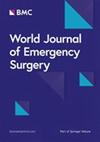急诊腹部手术后与健康相关的生活质量
IF 5.8
1区 医学
Q1 EMERGENCY MEDICINE
引用次数: 0
摘要
患者的生存和生活质量是评估治疗价值的关键因素。然而,关于急诊腹部手术后患者健康相关生活质量(QoL)的轨迹和关键决定因素的证据有限。我们使用EQ-5D-3L问卷对高危患者进行了为期8个月的随访,通过强化围手术期护理研究测量了患者的生活质量,总结了急诊腹部手术后患者的生活质量轨迹,并使用多变量回归模型将患者的人口统计学和临床特征、术前特征和手术后时间与他们的生活质量联系起来。在进一步的分析中,我们评估了术后患者特征的贡献。686例急诊腹部手术患者资料(50.4%为女性),平均年龄66.6岁(标准差12.8);50.1%以肠梗阻为手术指征),并对生活质量进行分析。术后不久(平均7.59天(SD 7.48)), EQ-5D-3L平均生活质量效用评分为0.21 (SD 0.46),在手术后中长期(即3至8个月),幸存者的平均生活质量效用评分为0.74 (SD 0.31)。患者的性别和术前死亡风险是术后短期生活质量的关键决定因素。除术后时间外,患者的性别、Charlson合并症指数、ASA身体状况和手术指征是影响术后中长期生活质量的主要术前预测因素。从术后特征来看,指数手术住院时间和生活质量测量前30天内的住院天数是中长期生活质量的进一步关键决定因素。患者个体、手术和恢复特征决定了急诊腹部手术后的生活质量,并有助于告知临床医生和患者讨论和评估腹部手术干预措施的价值。本文章由计算机程序翻译,如有差异,请以英文原文为准。
Health-related quality of life after emergency abdominal surgery
Patients’ survival and quality of life are key factors in assessing value of treatments. However, limited evidence exists about the trajectory and key determinants of patients’ health-related quality of life (QoL) following emergency abdominal surgery. Using the Enhanced Peri-Operative Care for High-risk patients study with measured QoL during eight months follow-up using the EQ-5D-3L questionnaire, we summarise the trajectory of patients’ QoL after emergency abdominal surgery and use multivariable regression models to relate patients’ demographic and clinical characteristics, pre-surgery characteristics, and time elapsed since surgery with their QoL. In further analysis we assess the contribution of post-surgery patient characteristics. Data from 686 patients undergoing emergency abdominal surgery (50.4% female; mean age 66.6 (standard deviation (SD) 12.8) years; 50.1% with intestinal obstruction as indication for surgery), with QoL measurements were analysed. Shortly after surgery (mean days 7.59 (SD 7.48)), the mean EQ-5D-3L QoL utility score was 0.21 (SD 0.46), which improved among survivors to 0.74 (SD 0.31) in the medium- to long-term (i.e., three to eight months) following surgery. Patient’s sex and preoperative risk of mortality were key determinants of QoL shortly after surgery. In addition to time since surgery, patient’s sex, Charlson Comorbidity index, ASA physical status and indication for surgery were key pre-surgery predictors of QoL in the medium- to long-term post-surgery. From post-surgery characteristics, duration of hospital admission for index surgery and further days in hospital within 30 days prior to QoL measurement were key further determinants of QoL in the medium- to long-term. Individual patient, surgery, and recovery characteristics determine QoL post-emergency abdominal surgery and can help inform clinician-patient discussions and assessments of value of abdominal surgery interventions.
求助全文
通过发布文献求助,成功后即可免费获取论文全文。
去求助
来源期刊

World Journal of Emergency Surgery
EMERGENCY MEDICINE-SURGERY
CiteScore
14.50
自引率
5.00%
发文量
60
审稿时长
10 weeks
期刊介绍:
The World Journal of Emergency Surgery is an open access, peer-reviewed journal covering all facets of clinical and basic research in traumatic and non-traumatic emergency surgery and related fields. Topics include emergency surgery, acute care surgery, trauma surgery, intensive care, trauma management, and resuscitation, among others.
 求助内容:
求助内容: 应助结果提醒方式:
应助结果提醒方式:


